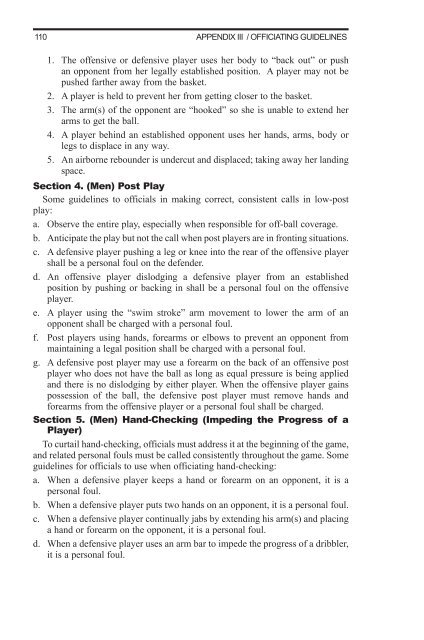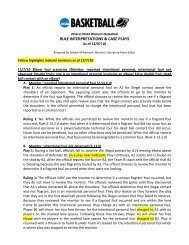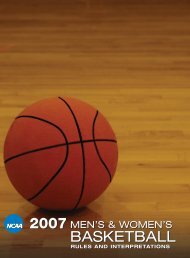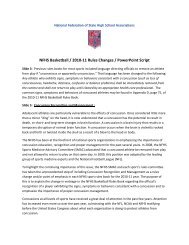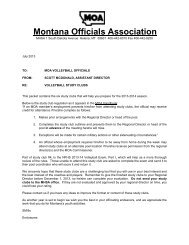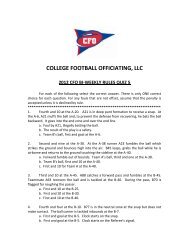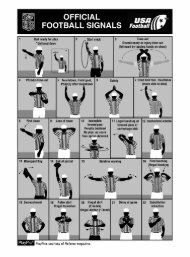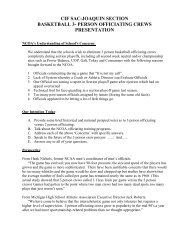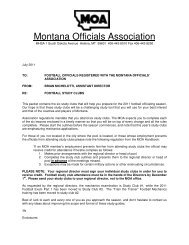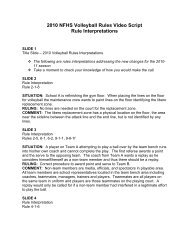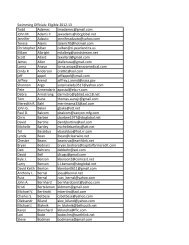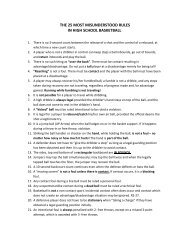2011-12 AND 2012-13 MEN'S AND WOMEN'S RULES - NAIA
2011-12 AND 2012-13 MEN'S AND WOMEN'S RULES - NAIA
2011-12 AND 2012-13 MEN'S AND WOMEN'S RULES - NAIA
Create successful ePaper yourself
Turn your PDF publications into a flip-book with our unique Google optimized e-Paper software.
110<br />
Appendix III / Officiating Guidelines<br />
1. The offensive or defensive player uses her body to “back out” or push<br />
an opponent from her legally established position. A player may not be<br />
pushed farther away from the basket.<br />
2. A player is held to prevent her from getting closer to the basket.<br />
3. The arm(s) of the opponent are “hooked” so she is unable to extend her<br />
arms to get the ball.<br />
4. A player behind an established opponent uses her hands, arms, body or<br />
legs to displace in any way.<br />
5. An airborne rebounder is undercut and displaced; taking away her landing<br />
space.<br />
Section 4. (Men) Post Play<br />
Some guidelines to officials in making correct, consistent calls in low-post<br />
play:<br />
a. Observe the entire play, especially when responsible for off-ball coverage.<br />
b. Anticipate the play but not the call when post players are in fronting situations.<br />
c. A defensive player pushing a leg or knee into the rear of the offensive player<br />
shall be a personal foul on the defender.<br />
d. An offensive player dislodging a defensive player from an established<br />
position by pushing or backing in shall be a personal foul on the offensive<br />
player.<br />
e. A player using the “swim stroke” arm movement to lower the arm of an<br />
opponent shall be charged with a personal foul.<br />
f. Post players using hands, forearms or elbows to prevent an opponent from<br />
maintaining a legal position shall be charged with a personal foul.<br />
g. A defensive post player may use a forearm on the back of an offensive post<br />
player who does not have the ball as long as equal pressure is being applied<br />
and there is no dislodging by either player. When the offensive player gains<br />
possession of the ball, the defensive post player must remove hands and<br />
forearms from the offensive player or a personal foul shall be charged.<br />
Section 5. (Men) Hand-Checking (Impeding the Progress of a<br />
Player)<br />
To curtail hand-checking, officials must address it at the beginning of the game,<br />
and related personal fouls must be called consistently throughout the game. Some<br />
guidelines for officials to use when officiating hand-checking:<br />
a. When a defensive player keeps a hand or forearm on an opponent, it is a<br />
personal foul.<br />
b. When a defensive player puts two hands on an opponent, it is a personal foul.<br />
c. When a defensive player continually jabs by extending his arm(s) and placing<br />
a hand or forearm on the opponent, it is a personal foul.<br />
d. When a defensive player uses an arm bar to impede the progress of a dribbler,<br />
it is a personal foul.


